Global Digital Marketing & Retail by Alex 87
Inspiration from across the world for retail enthusiasts, e-commerce professionals, marketing lovers and technology fans. Welcome back! I summarized some great links again, I stumbled upon this week.
🤩Salesforce: Agentforce world tour in Amsterdam
Yesterday I visited the Salesforce Agentforce world tour. I have been before to salesforce world tours and they are always very well organized and very inspirative. It’s like visiting the future. To see what is coming next, but also what trailblazing companies are already doing now. Let’s say that this is one of the conferences that gives me goosebumbs and energy.
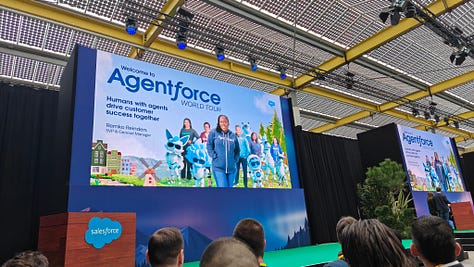
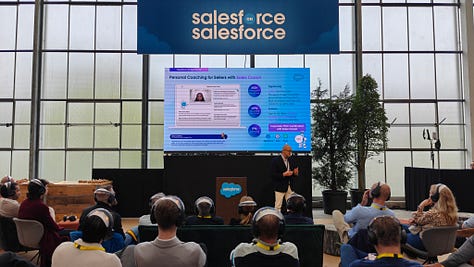


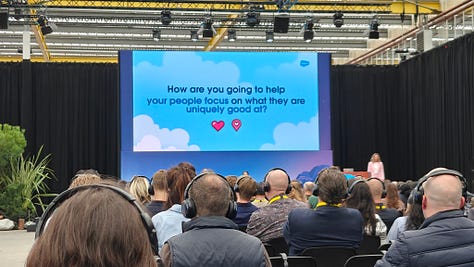




I can write a few newsletter editions on all I saw at the conference. I won’t do that, but I share a few pictures I made. Worth to dig in.
This year the world tour is all about AI and Agents, and specifically agents working together. It’s very easy to setup AI agents via the salesforce platform and even AI enhances the AI agents descriptions and setup (instructions). They already have a loooong list of AI agents in their Agent marketplace.
It was emphasized, humans and AI agents collaborate, and it’s the combination that makes it work.
Every sales rep gets a coach an AI coach that helps them close the deal(s) but also that can real time analyze and advice during calls.
An AI agent can not do anything without data, so they zoomed in on that a lot as well. And not only data in general but also on data security, and that presentation was also very interesting. Using AI agents unlock lots of security risks. People have much more access to data then you think and AI finds it. It finds passwords, it finds opportunities that are close to closing and much more. The solution includes real time monitoring and guardrails on prompts. Very well presented by a company called Varonis.
Shift from manual tasks to strategic oversight for marketers. Agentic AI transforms the customer experience and makes humans more productive. The way I see it by reducing workload on manual tasks, marketers, like myself, can explore new strategies, experiment with emerging technologies, and drive innovation in campaigns. It requires continious learning, what I already do a lot and a more growth mindset. I see it as very positive these changes.
I talked to a few consultants at the event as well. It’s all about getting the data right, start small and scale up. Learn and test a lot. Just like in software development in my opinion.

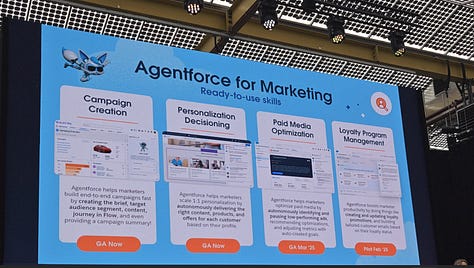
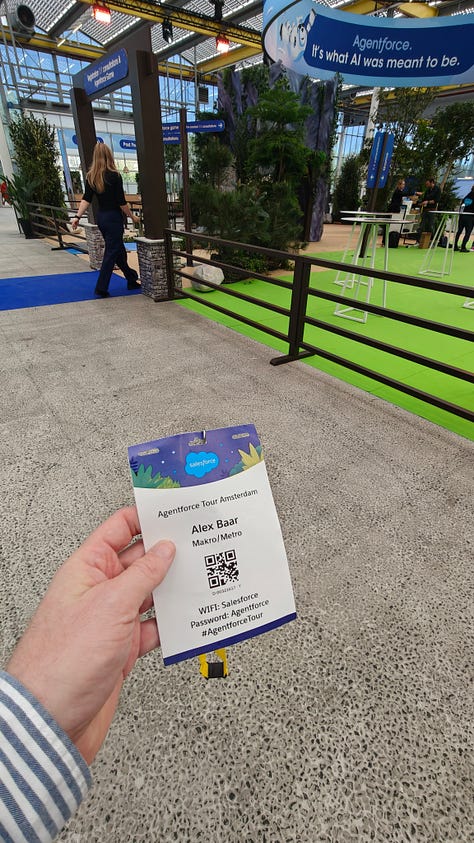
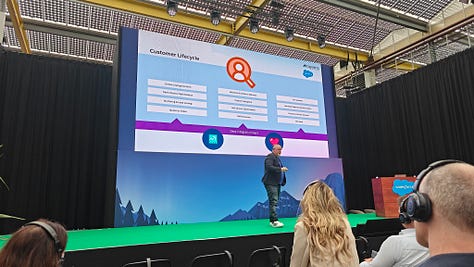
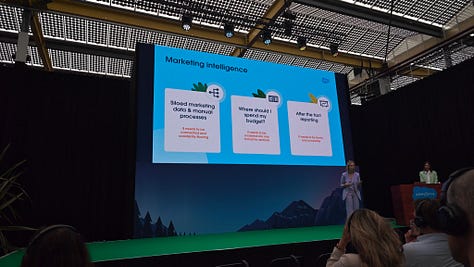
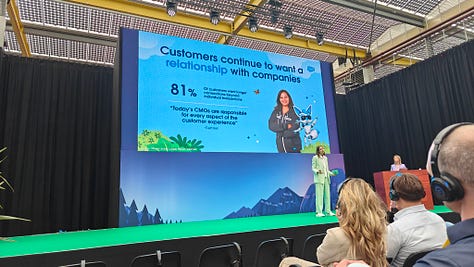
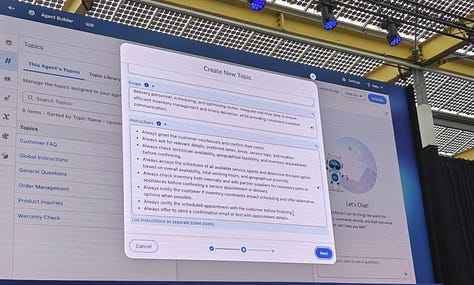


Fisher and Paykel, a company selling kitchen equipment, already uses agentforce in customer interactions as you can see in this video that they also demo-ed real time during the conference by calling with an AI customer service representative.
The future is so interesting, but we need to adapt and constantly learn. I think this time the changes come much more rapidly as for example in the 90’s with the upcoming internet.
What if, every company used SalesForce how would the world then look like?
Details: https://invite.salesforce.com/agentforceworldtouramsterdam2025
📊Tars: a product metric game changer | how to measure the impact of features
I really like product management, enhancing products, boosting customer experience. In that it’s important to measure usage of features, you don’t want an overkill, you want to add value. The Tars framework helps you in doing that. I share this here, it’s I think a very good article and useful for everyone in PM. A short summary below (via Vitali Friedman)
👩🏻🦱 Feature target audience (%)
Quantify the target audience by exploring what percentage of all product’s users have this specific problem that a feature aims to solve. Approximate the target audience by studying existing or similar features that try to solve similar problems.🗂 Feature adoption (%)
Track how many users actually engage successfully with a feature over a specific time period. High feature adoption suggests that the problem was severe and impactful. Low adoption suggests the problem has simple workarounds.🗃️ Feature retention (%)
Study how many users who engaged with the feature actually returned to it and keep re-using it in their sessions. Usually it’s a strong signal for meaningful impact. However, high retention alone doesn’t say how successful people are in task completion. If a feature has >50% retention across users, we can be quite confident you have a feature of high strategic importance. A 25–35% retention rate is likely of medium strategic significance, and retention of 10 -20% is of low strategic importance.❤️ Satisfaction rate (CES)
Run research to understand how easy it was for users to solve their problem after they used our feature. Use a Customer-Effort-Score survey, and ask only retained users to understand if there are any hidden problems with retention🎯 Bonus: Task Completion (%)
Always additionally measure task completion rates for most critical tasks and flows that users have to perform. Identify 10–12 tasks, and track how users actually complete them — along with accuracy and completion times.
Low adoption doesn’t necessarily mean failure. It might be that a feature wasn’t surfaced well enough in user journeys or that we over-scoped the target population.
A great framework to keep in mind to prioritize and track performance of features, and evolve product over time.
https://uxdesign.cc/tars-a-product-metric-game-changer-c523f260306a
Unpaywalled: https://archive.ph/901rJ
🇹🇭 Lazada unlocks seller AI
I always use Lazada when I am in Thailand. It’s a great marketplace and I always try it and let product deliver to my hotel. I wrote on that earlier here.
Now Lazad is boosting AI
Lazada’s latest report shows 70% of Thai sellers seek AI support—prompting the platform to roll out a new suite of smart tools and tailored guidance that accelerate digital growth and streamline success.
This comes as AI proves its commercial potential. A recent study by McKinsey & Company found that businesses using AI in sales and marketing can increase revenue by up to 15% while reducing operational costs by as much as 20%. In Southeast Asia alone, AI is expected to contribute over UScopy trillion to the regional economy by 2030, underlining the transformative role AI will play in commerce and digital entrepreneurship.
Lazada continues to invest in seller-focused innovations with a suite of new Generative AI (GenAI) features that are designed to make selling easier, smarter, and more effective:
AI Smart Product Optimisation: This GenAI tool helps sellers refine titles, descriptions, and images while enabling virtual try-ons, background changes, and model placement for professional-quality listings in minutes.
AI-Powered Translations: Automatically translates product content into multiple local languages, allowing sellers to effortlessly reach diverse markets across the region.
Lazzie Seller: An AI assistant built into the Alibaba Seller Centre (ASC), offering instant responses to FAQs, business insights, feature navigation, and store risk assessments—boosting efficiency and decision-making.
And
https://lazada-com.oss-ap-southeast-1.aliyuncs.com/216-press-release.pdf
🇦🇪 UAE : Six upcoming transport projects that will revolutionise travel in Dubai
If you want to see what the future brings, you need to visit Asia and the Middle East. They change much more rapid then most of Europe. This article on Dubai’s transportation ambitions emphasizes this. Now combine this with great technology and you can see where it is heading.
That’s it for this edition, thank you for reading, liking and subscribing
Curious for more immediatly?
Check out my archive of all previous newsletters:




